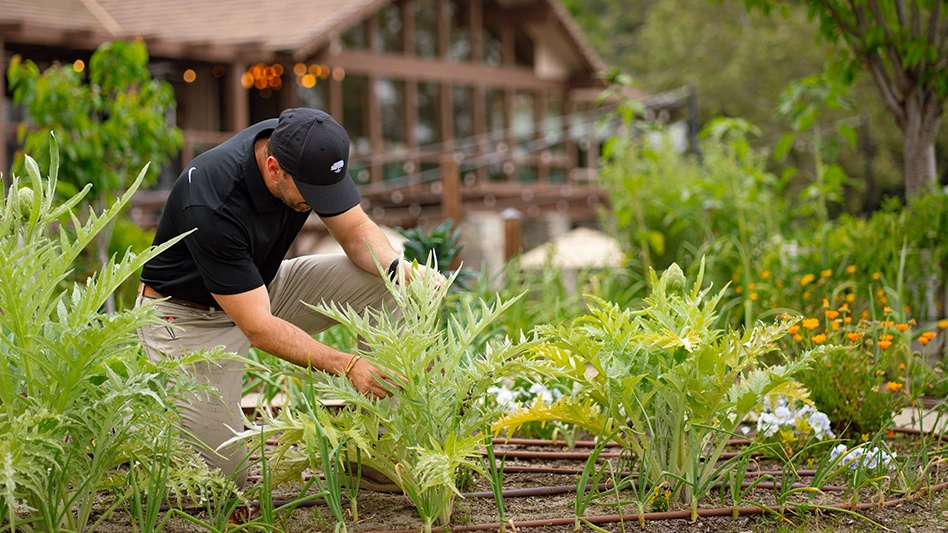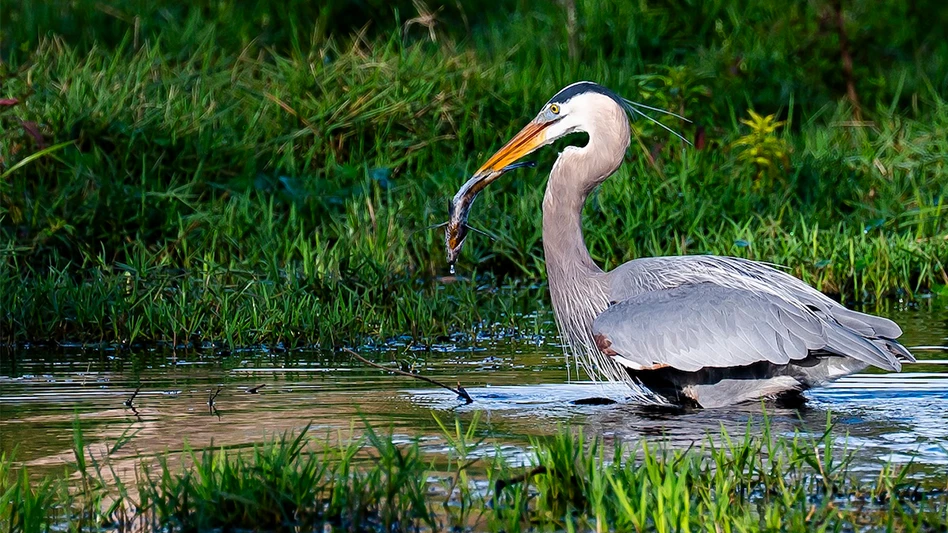

For those who played golf in the pre-2000s, seeing monarch butterflies on the grounds come summertime was as synonymous as drawing squares on a scorecard.
Today: Not so much.
Whether it be commerce, climate change, deforestation, products — or a combination thereof — threats to thousands of acres of migratory monarch habitats have seen a dramatic decline in population of the nation’s most notable and noticeable butterfly across the past quarter century.
By 2021, the population was so low as to warrant the monarch being listed as “endangered” by the International Union for the Conservation of Nature; in years subsequent, a slight flutter of hope saw the species reclassified as “vulnerable.”

The domestic golf community has played its part in the slight orange-and-black rally.
“There’s been a pretty well documented loss in the monarch butterfly population, with some experts charting it as much as over 90 percent,” says Frank LaVardera, Audubon International’s director of environmental programs for golf. “And a number of factors have contributed to that, in particular through what they call the major ‘flyways,’ where the monarchs make their annual pilgrimage, coming down from Canada to the United States and then down to Mexico.”
In 2018, Audubon International, buoyed by a later grant from the National Fish and Wildlife Foundation, unveiled its “Monarchs in the Rough” program, an endeavor that enabled Audubon International to provide, gratis, regionally correct milkweed seed — the sole plant on which monarchs can lay eggs and their caterpillars can feed — to golf properties that would guarantee an establishment of at least one acre (not continuous) to creating monarch habitat. In addition, Audubon provided participants with a wildflower mix, habitat signage and a guidebook to assist with garnering positive results.
“The typical golf course, in general, has somewhere around 90 acres of what we call ‘managed turf,’ and, of course, the 90 typically sits on much larger pieces of property,” LaVardera says. “So, the thinking was if we could promote the establishment of monarch habitats, that could contribute to help offset the decrease in population.”
Offset achieved, in part. While tracking numbers have evidenced a rebound from the 2020 monarch count nadir, today’s quantity is still dramatically lower when compared with pre-millennium monarch stats.
Yet, swing by swing and wing by wing, “Monarchs in the Rough” has found ample fairway, with the Audubon International initiative resulting in more than 800 participating courses across the country, collectively establishing over 1,800 acres of new monarch habitat.
To ensure such progress, however, further program fuel is welcomed. With the grant funds now expired, “Rough” is only available to certified member courses of Audubon International’s celebrated Cooperative Sanctuary Program for Golf program, and the non-profit is now actively interested in a finding a sponsor to back the “Rough” endeavor anew.
The butterfly effect
The monarch is as well known for its striking color aesthetic as it is for the species’ unique fortitude and instinct.
The only butterfly species known to make a two-way migration, consider that the monarch’s annual autumn western migration, as they come up and down the California coast, traveling to Southern California and as far as Baja, Mexico, accounts for an impressive 2,000-mile trip. The migration east of the Rocky Mountains? That’s an even more astounding 3,000 miles from Canada to central Mexico, seeing the little 0.5-gram dudes traveling as far as 100 miles a day, and climbing to elevations of approximately 1,200 feet. Of even further wonder is that the monarchs migrating north will die long before their descendants head south again, something of a miraculous journey considering that autumn migrants have never been to their destination.
In Southern California, where the monarch migration makes a spring or early summer pitstop, one popular resort destination has found particular humanity in habitat.

The 27-hole Temecula Creek Golf Club, wound about the Temecula Creek Inn, took full flight with Audubon International’s “Rough” program three years ago and has derived results both environmental and educational.
“I’ve always been interested in environmentally friendly design,” Temecula Creek superintendent Brett Wininger says. “So, when I got into the position of being able to make landscape decisions, I jumped at the opportunity to take a step back and ask, ‘What can I do?’ with this responsibility of managing 150 acres of manicured turf. Then it was, ‘What can I do with our sustainability efforts to give back to the environment?’”
Holding a degree in landscape architecture from Cal Poly Pomona, Wininger sought to design a habitat space that advantaged the attention of both those on-course and the property’s ample non-golfer foot traffic.
“I didn’t want to just throw the milkweed seed in the peripheries, and have it just come up in the rough or O.B. areas,” he says. “I wanted to take the opportunity to construct not only a habitat for the monarchs when they make their migration here, but to also create an educational space.”
Wininger ultimately selected a 9,000-square-foot space close to the golf shop, close to resort lodging and close to the course, but also out of the way of any errant balls; the area, en route to the opening tee of the grounds’ Oaks Course, had previously been a canvass of ornamental turfgrass.
“I wanted a space that was fun for everybody — that would allow guests to meander through and see everything,” Wininger says. “And after looking at the signage which Audubon provided us, and then looking at the space I chose — which is kind of a longer shape — I thought it would be cool to create the habitat in the shape of a monarch. Basically, the D.G. pathways in the habitat are based off of the signage, with the butterfly’s body and wings, and the planter areas basically filling in the color of the wings.”
Spread across four planters, Wininger was strategic with his design, color palate, flower choices and milkweed spread.
“Every planter has milkweed, which is a combination of common milkweed, narrowleaf milkweed and some tropical milkweed, which I get from a local source,” he says. “And milkweed, being a pretty invasive species, it reseeds itself very readily, so once you plant one, it’ll reseed itself multiple times. And it’s kind of a beautiful thing about that — if it’s provided an environment in which it’ll thrive, you plant one and it expands on itself. So, you don’t need to go back and purchase it year after year.”

Every planter was planned with purpose for both monarchs and property guests. The superintendent also added trellises throughout the space, created for the caterpillars to hang and create their chrysalises.
“The first planter is essentially an entryway with native grasses, which serve as shelters for other insects and pollinators,” Wininger continues. “There are also sundrops, and then I spread some California poppy, which is the official state flower, which I put in every planter. And then, in another planter, we have three different kinds of citrus trees — orange, lime and lemon. That’s because the butterflies not only like the nectar on the pollen, they’ll also feed on any decaying fruit. So, I planted those as a secondary food source.”
Flower and plant options for the insects — including Rudbeckia (black-eyed Susan), Echinacea, Lantana and Helianthus (sunflowers) — were a key part of the habitat plan.
“Even with the milkweed, if the butterfly doesn’t have multiple options of different flowers, they can kind of get bored and move on very quickly,” Wininger says. “And you also don’t necessarily want flowers with one big flower on a plant, but with multiple different flowers providing multiple feeding opportunities.”
Space for all manner of non-monarch visitors has also proved vital to success and visibility.

“The back two planters, one of them has three 4x4 posts with 1/8th-inch holes drilled in, and I did that because carpenter bees are known to be better pollinators than your standard honey bee,” Wininger says, “and they’re also solitary bees, in that they don’t have a queen that they protect. So, they don’t necessarily sting you. They do have stingers, but it’s pretty rare that a carpenter bee will sting a person.”
Per Audubon International’s hopes and aims with “Rough,” a domino effect has taken hold with monarch habitat spaces.
“It has brought awareness to this species’ declining numbers. Participating courses have received a fair amount of publicity for this program and golfers have noticed what’s going on,” LaVardera says. “And this amount of attention also has spun off to others near the participating courses — individual property owners, commercial property owners — creating their own habitats. We’ve received a number of calls from people at non-golf properties, and we’ve referred them where to get seed and so forth.”
Wininger’s phone has also been ringing.
“Right by the golf course, there’s a botanical garden which focuses more on roses and things like that,” he says. “The year after we built our monarch habitat, they had some of their people come out here to see what we did, and then they built their own.”

Along with working to save a species, concurrent benefit has come by way of eliminating peripheral turf. Changing the area to a habitat space has resulted in Temecula Creek saving more than 250,000 gallons of water annually.
“That area had three irrigation heads, so, by removing those, that’s 600 gallons of water a night we’re saving in that one specific area,” Wininger says. “And we’ve replaced that with drip irrigation for the habitat, which doesn’t have any loss through evaporation from the soil or any runoff from overwatering. It’s all getting absorbed in the soil and used by the plants.”
Along with earning Temecula Creek Inn the 2023 “Good Earthkeeping Award” from the California Hotel & Lodging Association, Wininger believes that the habitat passion project has filled his mantle with much more than mere hardware.
“If you’re passionate about anything you’ll make time,” he says. “I mean, if you have the land — and, really, you don’t need that much land for this — it’s a great thing to do, a responsible thing to do and we’ve all found it a fun thing to be a part of.”

Explore the July 2024 Issue
Check out more from this issue and find your next story to read.
Latest from Golf Course Industry
- From the publisher’s pen: Technology diffusion and turf
- Applications open for 2025 Syngenta Business Institute
- Smart Greens Episode 1: Welcome to the digital agronomy era
- PBI-Gordon promotes Jeff Marvin
- USGA investing $1 million into Western Pennsylvania public golf
- KemperSports taps new strategy EVP
- Audubon International marks Earth Day in growth mode
- Editor’s notebook: Do your part





